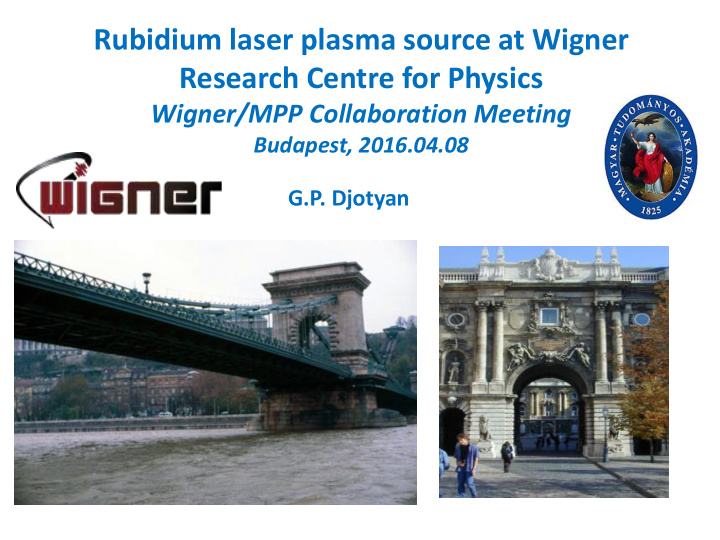



Rubidium laser plasma source at Wigner Research Centre for Physics Wigner/MPP Collaboration Meeting Budapest, 2016.04.08 G.P. Djotyan
Motivation and Outline 1. Generation of laser plasma and real-time diagnostics methods developed in our studies. 2. Propagation simulation techniques for a strong pulse in multilevel resonant optically dense atomic media. 3. Application of coherent control methods for diminishing threshold conditions for ionization and conditions minimizing back-action of the media on the propagating ionizing laser pulse. 4. Study of the physics of the processes of ionization and laser plasma generation in extended multilevel resonant media.
Wigner/MPP Collaboration Meeting: Program 9:45-10:00. A. Czitrovszky (Wigner RCP): Laser Physics at Wigner Research Center. 10:00- 10:30. P. Muggli (MPP): Laser source for extremely homogeneous plasma generation at Max-Planck-Institute for Physics. 11:00 -11.30. M. Kedves (Wigner RCP): Laser plasma generation and real-time diagnostics at Wigner Research Center. 11:30 -12:00. J.Moody (MPP): Results on laser plasma generation at Max-Planck- Institute for Physics. 12:00-12:30. Anna-Maria Bachmann (MPP): Laser plasma radius measurement. Lunch 12:30 -13:45-14:45.Visit to the Wigner Laser Lab (B.Raczkevi) 14:45-15:15. J. Kasparian (University of Geneva): Filamentation of ultrashort laser pulses. 15:15-15:45. G. Demeter (Wigner RCP): Solving the Maxwell-Bloch equations of resonant nonlinear optics on computers. 15:45-16:15. Mathias Hüther (MPP):Laser Damage Measurements. 16:45 - 17:15. I. Barna (Wigner RCP): An effective theory for electron acceleration in underdense plasma. 17:15 - 17:45. M. Pocsai (Wigner RCP): Ab initio studies of Rubidium ionization processes. 17:45-18:30. Roundtable: Summary and Discussions Dinner
Generated laser plasma
Extended Plasma Generation: The real-time detection scheme
Time dependence of the transmitted signal Graph 1
Time Dependence of the Transmitted Signal at a higher temperature Graph 2
The physical mechanisms of the real-time plasma diagnostics
Update of the setup: Rb cell with implanted electrodes for direct measurement of the Rb plasma electron density
Update of the laser source: Hydra laser from the Coherent: Comparison and new possibilities The present hELIos laser Parameters of the Coherent Hydra parameters: 1 kHz / 4 mJ Ti- laser: 10 Hz repetition rate, 24 mJ sapphire laser system, 30-40 fs pulse energy, 30-40 fs pulse pulse duration , ~800 nm duration, ~800 nm wavelength wavelength
Rb transition lines and the ionization scheme Why not to pre-excite the atoms to higher states 7s and 5d to have lower threshold for tunneling ionization? The threshold may be diminished by two orders of magnitude !
Final population of the ground state 5s Aladi M , Bakos JS , Djotyan GP et al. Pre- excitation studies for rubidium-plasma generation. NUCL INSTR. & METH. A, 740 (11) pp. 203-207. (2014)
Final populations of the excited states 5d and 7s: dependence on direction of the chirp Advantages of using frequency chirped laser pulses: i . Robustness of the atomic population transfer against variation of parameters of the laser radiation ii. Applicability in both homogeneously and in-homogeneously broadened media, e.g. hot vapors (Doppler-broadening) or solid-state environment ii. Ability to select a target state even in the case of broadband (e.g. ultra-short) laser pulses in the case of spectrally non-resolved manifold of atomic (molecular) energy levels.
Updates under way and plans for the near future Experiment: - A new Ti:Sa laser system with more than 24 mJ pulse energy and 35-40 fs pulse duration is in the purchasing process. Using this laser system, it will be possible to increase the part of the ionized atoms (the diameter of the plasma channel). - To use glass or quartz cells with implanted electrodes for direct diagnostics of the plasma. - To use frequency chirped pre-pulses to pre-excite the atoms before ionization by the strong pulse: Decreasing of the threshold intensity by two orders of magnitude along with emptying the atomic transition resonant to the strong pulse that prevents stretching of the pulse. Theory: - Numerical simulation of ionization of Rb atoms in the field of strong ultrashort laser pulses taking into account all the spectrum of variation of the Keldysh parameter, from multi-photon to tunneling and over-the- barrier ionization. - Numerical simulation of propagation of intense laser pulses with and without frequency chirp under the condition of plasma generation in multi-level atomic media modeling Rb atomic vapors.
Conclusions The presented system allows to perform a detailed analysis of the laser plasma formation process in the extended geometry, allowing to understand the underlying physical processes. This analysis will allow to find optimal parameters for the strong ionizing laser pulse to create extremely homogeneous plasma in the extended geometry. A scheme for significant diminishing of the threshold of the plasma generation is under consideration for experimental realization using pre-excitation of Rb atoms by frequency chirped pulses. Also, this scheme allows emptying the resonant transition for the strong ionizing pulse eliminating dispersion effects during its propagation.
Recommend
More recommend